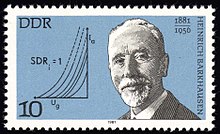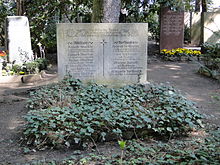Heinrich Barkhausen
Heinrich Georg Barkhausen (born December 2, 1881 in Bremen , † February 20, 1956 in Dresden ) was a German physicist . In physics and technology, the magnetic Barkhausen effect , the Barkhausen circuit , the Barkhausen short oscillation , the Barkhausen tube formula and the Barkhausen stability criterion are named after him.
Beginnings
Education
Heinrich Barkhausen came from a respected bourgeois family in Bremen. Already in his early youth he showed an interest in technology and the natural sciences, whereupon his Abitur in the spring of 1901 was followed by a six-month internship in the railway repair workshop in Bremen, which was followed by a degree in physics. Barkhausen began at the Technical University of Munich , followed by the universities of Berlin (1902), Munich (1903) and Göttingen (1903), where he finally accepted an assistant position at the Institute for Applied Electricity with Hermann Theodor Simon (1870-1918) in 1906, who made him Dr. phil. PhD.
PhD thesis
In 1907, Barkhausen's dissertation “The problem of vibration generation with special consideration of fast electrical vibrations” was published as a book and met with a great response. Eugen Nesper said about this work that it ended the chaos of views in the area of vibration by treating the complex of questions clearly, extensively and very vividly.
Berlin time
Immediately after his work was published, Barkhausen received a job offer from Siemens in Berlin - such an offer was still unusual at the time. There he worked as an engineer and on the side on a habilitation thesis , which he completed in 1910. Thereupon he was admitted as a private lecturer for electrical engineering by the TH Berlin .
At the TH Dresden
Institute foundation
In 1911 Barkhausen received a call to the TH Dresden as associate professor and director of the newly founded institute for low-voltage technology. It was the first independent institute for low-voltage technology in Germany. In the summer semester of 1911 the first lectures were held on wired and wireless telegraphy and telephony . In the winter semester electrical measurement and an internship in low-voltage technology followed , in the summer semester 1912 the theory of lines and in the winter semester 1912/13 scientific basics of telephony and telegraphy . In doing so, Barkhausen pursued a new path: Until now, knowledge transfer was based on the design and construction of the devices and systems used in practice. Now the theoretical basics and functional relationships were in the foreground. However, theoretical lectures were always combined with illustrative examples. The Japanese Hidetsugu Yagi was among the first listeners .
The establishment of the institute required a lot of work, although initially there was not even a typist and then only a half-day assistant position.
Low-voltage technology around 1910
In Dingler's Polytechnisches Journal , Barkhausen said: "When electrical engineering is mentioned, the layman usually thinks of some impressive power output: rushing machines, rushing trains, cranes that lift fabulous loads without any visible effort, waterfalls that are robbed of their energy, to create light. Against such respect and admiration arousing achievements of high-voltage technology, weak-current technology seems to him, whereby he thinks of doorbell systems and all kinds of children's toys, as something petty without major economic importance. "
Electrical engineering began with experiments in low-voltage technology, the practical use of which became apparent from 1880 onwards in high- voltage technology . Applications of the low-voltage technology itself emerged with the message transmission only after 1900 on a small scale. Hardly anyone was interested in Barkhausen's lectures, and in the early days he had to laboriously recruit students.
First World War
With the beginning of the First World War , Barkhausen was "on leave" and from 1915 on as a scientific assistant to inspect the torpedoes of the Imperial Navy in Kiel . There he was commissioned to create a counterpart to the Morse code relay for telephony:
When transmitting messages, the signal power decreases with increasing distance due to the losses in the cable, so that the message is no longer perceptible from a certain distance. Larger telegraphy routes can be bridged using relay stations . Instead of the receiver, a relay, so to speak a remote-controlled Morse code key , is connected so that the same distance can be bridged again from this point on. Such a relay only knows the states on and off, but a stepless ( analog ) component would be required for telephony .
Robert von Lieben invented such a component in 1910 in the form of the electron tube with a grid, the triode. Heinrich Barkhausen secretly brought this tube to maturity. During his work he also discovered the discrete jumps on the magnetic reversal curve of iron, the Barkhausen effect, named after him, and researched the generation of centimeter waves by means of electron dance vibrations in the electron tube, the Barkhausen-Kurz vibration , which initiated the development of the time -of-flight tubes .
During the Weimar Republic
After the war Heinrich Barkhausen taught again at the university, where interest in his subject increased enormously with the beginning of radio in Germany . There was also great interest in the graduates from the radio industry and broadcasters. Since 1919 there had been plans for a new building for the institute, but it was out of the question for the whole time. From 1920, Barkhausen also dealt with electroacoustics and was faced with the problem that there was no volume measure, whereupon he introduced the unit of measurement of the phon in 1925 . The Bark scale is named after him. Barkhausen traveled to the USA in 1929 and to the Soviet Union in 1930 , received an honorary doctorate from the TH Darmstadt in 1932 and published an introduction to vibration theory .
Textbook for electron tubes
In 1923 the first volume of the textbook for electron tubes appeared, which was improved in 1924. The second volume followed in 1925 on tube transmitters, in 1929 the third on tube receivers and finally a fourth volume. This standard work was known to all radio designers until the end of the tube era, and this was the main reason why the name Barkhausen became a household name. To this day it is considered the most comprehensive and most important of its kind. In putting it together, he remained true to his line of interweaving theory and practice; it often shows the mathematically correct derivation of a relationship (e.g. Barkhausen's tube formula ) and underpins it with practical measurement knowledge, but can also conclusively explain deviations.
In 1955, Barkhausen revised the 7th edition himself. The last edition, edited by Eugen-Georg Woschni , appeared in 1965.
time of the nationalsocialism
In the 1930s, Barkhausen only continued to work with a few assistants. In November 1933 he signed the professors' declaration of Adolf Hitler at German universities and colleges . He traveled to Japan in 1938 and to Romania in 1942 . On February 13, 1945, the institute finally fell victim to the bombing raid on Dresden , whereupon it was "on leave" in March 1945. Thereupon he and his wife left Dresden and stayed with relatives in the Lüneburg Heath.
post war period
After a seven-day journey full of privation, Heinrich Barkhausen was able to return to Dresden in June 1946. Together with his assistant Heinz Schönfeld - at the age of 65 - he built up the Institute for Low Current Technology again from small beginnings. He made rapid progress and in 1950 was able to announce that “... a tremendous amount of structural work had been done at our university”. Now the new building, which had been planned since 1919, came about, the first section of which was completed in 1951. In 1949 Barkhausen received the GDR National Prize, Second Class for Science and Technology, and on September 1, 1953, he retired as professor and director of the Institute for Low Voltage Technology. In the last years of his life, Barkhausen also took part in transistor development. For the Technical University of Dresden he gave the name to the main building of the Faculty of Electrical Engineering and Information Technology.
Heinrich Barkhausen died in Dresden in 1956. His grave is on the Tolkewitz urn grove .
Honors
In 1943 he was elected a full member of the Saxon Academy of Sciences and in 1949 of the German Academy of Sciences in Berlin .
Appreciation
A building of the TU Dresden, the Barkhausen-Bau , was named after Heinrich Barkhausen . In addition, a street in Dresden- Räcknitz bears his name. The Dresden Materials Research Association, the TU Dresden and EUCEMAN have been presenting the international Dresden Barkhausen Award every year since 2006. In 2000 he was voted one of the “100 Dresdeners of the 20th Century” in the daily newspaper “ Dresdner Latest News ”.
Works
His four-volume monograph textbook of electron tubes, electron tubes and their technical applications , Hirzel-Verlag Leipzig
- Volume 1: General Basics
- Volume 2: Amplifiers
- Volume 3: Feedback
- Volume 4: Rectifiers and Receivers
literature
- Klaus Lunze (Red.): Heinrich Barkhausen . Festschrift, published by the Barkhausen Committee at the Academy of Sciences of the GDR, Dresden 1981.
- Eugen-Georg Woschni : Heinrich Barkhausen and the development of electronics. Akademie-Verlag, Berlin 1988.
- Robert Volz: Reich manual of the German society . The handbook of personalities in words and pictures. Volume 1: A-K. German business publisher, Berlin 1930, DNB 453960286 .
- Dieter Hoffmann : Barkhausen, Heinrich . In: Who was who in the GDR? 5th edition. Volume 1. Ch. Links, Berlin 2010, ISBN 978-3-86153-561-4 .
swell
- Heinrich Barkhausen's written estate has been kept in the university archive of the Technical University of Dresden since 2016 and its content has been made accessible.
Individual evidence
- ↑ H. Barkhausen: The problems of weak current technology. In: Polytechnisches Journal . 326, 1911, pp. 513-517.
- ↑ 100 Dresden residents of the 20th century . In: Dresdner Latest News . Dresdner Nachrichten GmbH & Co. KG, Dresden December 31, 1999, p. 22 .
Web links
- Portrait photo
- Literature by and about Heinrich Barkhausen in the catalog of the German National Library
| personal data | |
|---|---|
| SURNAME | Barkhausen, Heinrich |
| ALTERNATIVE NAMES | Barkhausen, Heinrich Georg |
| BRIEF DESCRIPTION | German physicist |
| DATE OF BIRTH | December 2, 1881 |
| PLACE OF BIRTH | Bremen |
| DATE OF DEATH | February 20, 1956 |
| Place of death | Dresden |


